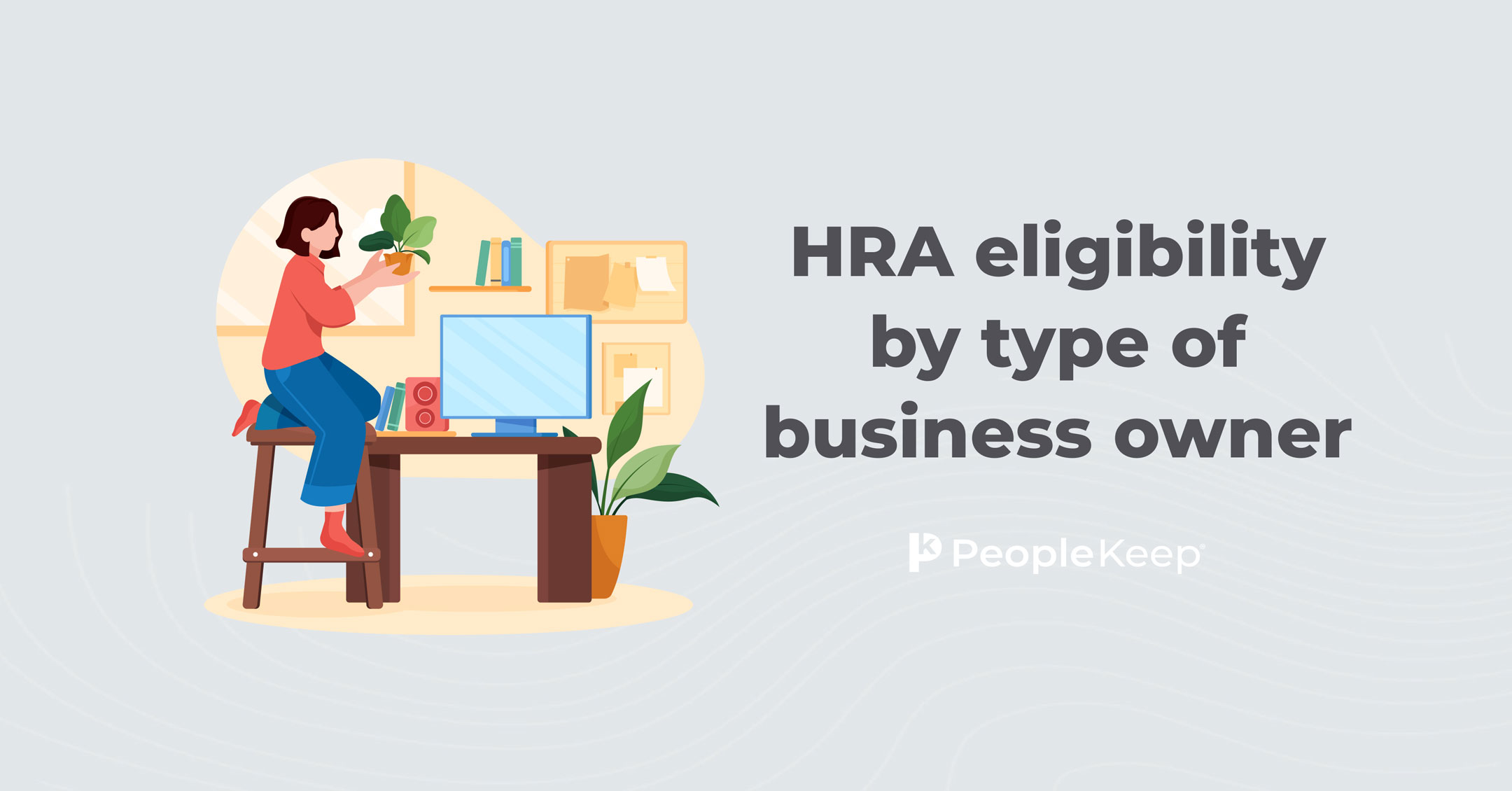What is coinsurance?
By Elizabeth Walker on October 3, 2025 at 9:15 AM
If you have a health plan — whether through your employer or the individual market — it’s essential to know common health insurance terminology. While some key terms may be confusing initially, learning them will help you understand which medical services your plan will pay for versus what you’ll pay out-of-pocket.
One common term is coinsurance. Knowing the coinsurance rates of the policies you’re shopping for will help you choose the right plan during the Open Enrollment Period and budget for any out-of-pocket costs. But what exactly does it mean?
In this article, we’ll explore what coinsurance is and how it works. We’ll also show you how your employer can help you save on coinsurance and other costs with a health reimbursement arrangement (HRA).
In this blog post, you’ll learn:
- How coinsurance affects your out-of-pocket medical expenses.
- The difference between coinsurance and copayments.
- How your employer can help you save on coinsurance and other health expenses.
What does coinsurance mean?
Coinsurance is the percentage of costs you must pay for a covered healthcare service after meeting your annual deductible. Your deductible is the amount you must pay out-of-pocket before your health insurance carrier starts to pay for your medical care.
Once you meet your deductible, your insurer will pay a part of the cost for each covered medical service you use, and you’ll pay the rest. Essentially, you and your insurance provider have “co-responsibility” over your medical expenses. This will be the case until you meet your out-of-pocket maximum.
Your insurance company tracks how much you’ve paid toward your deductible and out-of-pocket maximum throughout the plan year. They do this by sending you an explanation of benefits (EOB) after a medical service. Unlike common belief, EOBs aren’t bills; they’re medical claim summaries.
Here’s what a standard EOB will show:
- The service date.
- The service you received.
- The amount your plan paid for the service.
- How much of your medical bill you’re responsible for paying.
- How much you’ve paid toward your health insurance deductible.
- How to file a health insurance claim appeal.
- The cost for any medical services you received that your plan doesn’t cover.
If you’ve already met your deductible, your EOB will indicate the amount of coinsurance you owe for the service. Like a copayment, you’ll pay your coinsurance amount to your physician, hospital, or pharmacy.
How does coinsurance work?
Coinsurance rates are a fixed ratio. So, you’ll pay the same percentage on a covered health expense every time. Many insurance companies use an 80/20 coinsurance split rate. This means your insurer pays 80% of the service’s cost, and you pay the remaining 20%. But coinsurance rates vary by policy, so check your plan documents for your specific rate.
You must know the service's allowed amount to determine how much coinsurance you’ll owe. The allowed amount, also referred to as a negotiated rate or payment allowance, is the maximum amount that your insurance company has agreed to pay for a service. This information is also in your plan documents. If your medical service or item costs more than the allowed amount, you’ll pay the difference out-of-pocket.
Once you know the allowed amount and actual cost for a service, you can calculate your coinsurance.
Below is an example of how to calculate your coinsurance fee for an office visit:
|
Your plan’s coinsurance ratio |
Allowed amount for a primary care visit |
Actual cost of the primary care visit |
The amount your health insurer will pay |
The amount you must pay |
|
70/30 |
$100 |
$100 |
70% (or $70) |
30% (or $30) |
Remember that coinsurance doesn’t apply if you haven’t met your health insurance deductible. Once you meet your deductible, you’ll use coinsurance cost-sharing for covered services throughout the rest of the plan year.
Coinsurance charges also count toward your out-of-pocket maximum. This is the maximum amount you’ll pay for covered health services during your plan year. Out-of-pocket limits vary from plan to plan, but deductibles and coinsurance count toward it. Once you reach the maximum limit, your insurer will cover 100% of your remaining healthcare costs.
Many insurers don’t cover out-of-network care at all (except in the event of an emergency). But if they do, out-of-network services may have higher coinsurance percentages than in-network care. Out-of-network services also typically don’t count toward your out-of-pocket maximum either. Therefore, whenever possible, seek care at an in-network facility to minimize your medical bills.
How do the metallic tiers of coverage affect coinsurance?
If you have an individual health plan from the Health Insurance Marketplace, a state-based exchange, or a private exchange, coinsurance amounts can vary depending on the metal level of your plan. Though they can vary, the following are average coinsurance rates for Affordable Care Act (ACA) Marketplace health plans.
|
ACA plan type |
Average coinsurance rate |
The average amount the insurer pays |
The average amount policyholders pay |
|
Bronze plan |
60/40 |
60% |
40% |
|
Silver plan |
70/30 |
70% |
30% |
|
Gold plan |
80/20 |
80% |
20% |
|
Platinum plan |
90/10 |
90% |
10% |
These actuarial values for ACA plans are averages. The actual coinsurance rate for your plan may differ from the examples above.
What is the difference between coinsurance and a copayment?
Coinsurance and copays are both cost-sharing features that health insurance companies use to spread risk among their members. While they’re often mistaken for each other, they have key differences.
As mentioned earlier, coinsurance is the percentage of costs you're responsible for paying after meeting your deductible. In contrast, a copayment, or copay, is a set amount of money you must pay for a health service or item, regardless of whether you've met your deductible. They’re typically due at the time of service and don’t usually count toward your out-of-pocket maximum.
Your exact copay amounts will vary depending on the type of plan. Within an insurance policy, copays can also vary by the medical service or item you receive. Also, under the ACA, most health plans won’t charge you a copay or coinsurance if you receive preventive services.
Here are some example copay costs by service:
|
Hospital stays |
Primary care physician visit |
Prescription drugs |
|
$200 copay |
$30 copay |
$10 copay |
Even if you only pay small copays, they add up over time and can become expensive. So, like coinsurance and out-of-pocket maximums, check a plan’s details on copays before enrolling if you need frequent medical care to keep your costs down.
How an HRA can help you with your coinsurance costs
Whether you have an employer-sponsored group plan or an individual health plan from a public or private exchange, you may need help paying your out-of-pocket expenses. Even if you have a low-deductible health plan (LDHP) or a no-deductible plan, you’ll still likely have to pay coinsurance expenses and other costs.
If your employer is updating your company’s benefits package and asks for employee input, suggest an HRA. A stand-alone HRA works with individual health plans, while an integrated HRA can only supplement a group health plan. But in either case, only your employer can offer one.
Let’s go over both benefits below to give you an idea of how each can meet your needs.
Stand-alone HRAs
Stand-alone HRAs allow employers to reimburse employees tax-free for qualifying out-of-pocket medical expenses and individual health insurance premiums. With this type of HRA, your employer offers you a monthly allowance to spend on a health plan as well as medical care like prescription drugs, copays, and coinsurance. Once you buy an eligible expense, your employer will reimburse you tax-free up to your allowance amount.
Instead of a one-size-fits-all group health plan, a stand-alone HRA allows you to choose the individual health insurance coverage that works best for you while receiving reimbursements for your monthly premiums and other medical costs.
The following are the two types of stand-alone HRAs:
- The qualified small employer HRA (QSEHRA): The QSEHRA is for small employers with fewer than 50 full-time equivalent employees (FTEs). The QSEHRA has no minimum contribution limits, but the IRS sets annual maximum limits. Employees must have a health insurance plan with MEC to participate in the benefit.
- The individual coverage HRA (ICHRA): The ICHRA is for employers of all sizes. It works like a QSEHRA but has more customization options. There’s no maximum contribution limit, and your employers can vary allowances and eligibility. Employees must have a qualified individual health plan to use an ICHRA.
Integrated HRA
An integrated HRA, or a group coverage HRA (GCHRA), is an employer-owned health benefit that supplements a group health plan by reimbursing employees tax-free for out-of-pocket costs. You must enroll in your employer’s group health plan to take part in a GCHRA.
Here are some more highlights about the GCHRA:
- With a GCHRA, your employer can reimburse you for deductibles, coinsurance, copayments, and other qualified medical expenses. But you can’t receive reimbursements for health insurance premiums.
- They can work alongside any group healthcare plan. The employee benefit will also stay in place if your employer changes insurers or you change provider networks.
- There are no maximum annual contribution limits. Your employer can offer as much monthly allowance for reimbursement as they want.
- Your employer can offer different allowance amounts to different employee classes for greater personalization.
Your employer can choose to offer a GCHRA that covers all IRS-eligible medical expenses or limit eligible expenses to only those your insurance plan covers by requiring an explanation of benefits for reimbursement.
If your employer is looking for a way to boost your health benefits, a GCHRA can help you pay for your coinsurance and other healthcare expenses. That way, you pay less out of pocket and have greater control over your finances.
Conclusion
Understanding how coinsurance works is essential when choosing the right health insurance policy. If you have a health plan with a high deductible or coinsurance rate, you must prepare for the out-of-pocket expenses. Before enrolling in a health plan, carefully review the policy details to avoid unexpected and costly bills.
Fortunately, alternative health benefits are gaining popularity. If your employer offers you an HRA as part of your compensation package, take advantage of it. It’s a great way to afford your coinsurance payments and other medical costs during the year.
This article was originally published on November 1, 2023. It was last updated on October 3, 2025.
FAQs about coinsurance
In most cases, a health plan will have a coinsurance rate. However, some plans will not. Some plans instead have fixed copays for most covered medical services. If you don’t want to pay coinsurance, check a plan’s details before enrolling to see if it has one.
An employer-sponsored HRA can help you pay for your out-of-pocket medical expenses, including insurance. Other benefits that can help offset the cost of coinsurance include health savings accounts (HSAs), flexible spending accounts (FSAs), or ancillary policies such as critical illness or hospital indemnity plans.
Check out more resources
See these related articles

Common types of health insurance plans
Learn the pros and cons of the most common types of health insurance plans, such as PPOs, HMOs, HSA-qualified plans, indemnity plans, and alternatives.

Can I have an HRA and an FSA at the same time?
Learn if you can have an HRA and an FSA at the same time. Understand the rules, benefits, and how these accounts can work together for healthcare costs.

HRA eligibility by type of business owner
Are you a business owner wondering if you can participate in an HRA? Find out if you meet the eligibility criteria with this comprehensive guide.



